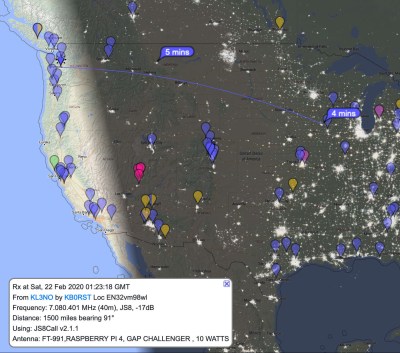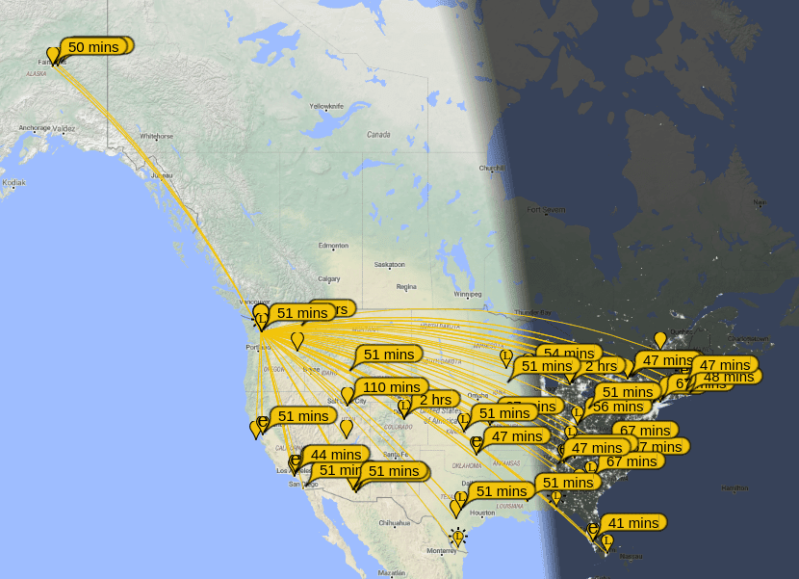While most of us carry cell phones that have GPS and other location services, they require a significant amount of infrastructure to be useful. Drive from Washington to Alaska like [Lonney] did a while back, where that infrastructure is essentially nonexistent, and you’ll need to come up with some other solutions to let friends and family know where you are.
A tool called the Automatic Packet Reporting System (APRS) is fairly robust in the very high frequency (VHF) part of the amateur radio spectrum, but this solution still relies on a not-insignificant amount of infrastructure for the limited distances involved with VHF. [Lonney] adapted a few other tools to get APRS up and running in the HF range, letting his friends keep tabs on him even from the most remote locations.
 The build relies on a second piece of software called JS8Call which is a text-based mode that allows radio operators to communicate “keyboard to keyboard”. It has a number of interesting features beyond this basic functionality though, including message forwarding. The software in [Lonney]’s build allows a small computer equipped with a GPS receiver to gather its location information, compose a brief message in JS8Call, and then send it to the APRS network in the high frequency (HF) portion of the spectrum which supports much further communications distances than VHF generally allows.
The build relies on a second piece of software called JS8Call which is a text-based mode that allows radio operators to communicate “keyboard to keyboard”. It has a number of interesting features beyond this basic functionality though, including message forwarding. The software in [Lonney]’s build allows a small computer equipped with a GPS receiver to gather its location information, compose a brief message in JS8Call, and then send it to the APRS network in the high frequency (HF) portion of the spectrum which supports much further communications distances than VHF generally allows.
The build goes a little beyond the functionality of widely-available radio software, though. He’s also written scripts that automate a lot of the tricky parts of dealing with a car and getting radios set up in one for a road trip, including automatic startup and shutdown. Originally this was built with a Raspberry Pi but he’s since switched to a laptop. He’s also done some testing on various bands and found the 40-meter band to be the best compromise between activity and range, with more than enough of each to make the long trip again.
For those unfamiliar with JS8Call, we’ve touched on it briefly with a few builds like this digital HF SDR transceiver which supports the protocol, but the short story is that it’s built on another tool called FT8 which was originally designed for quick contacts using weak signals. JS8Call essentially expands the functionality of this fairly revolutionary method of radio operation.

















We used ARPS to keep track of friends as they traveled in a snowstorm. Very useful .
Bryan: Great Article, do one on Reverse Beacon. Net. Another excellent web-based app.
Very cool!!
I love this project. JS8 is a fabulous. It’s great with weak signals, and thousands of miles of distance can be covered with 5 watts or less on HF, roughly around 3-28 mhz. Bandwidth and speed are the tradeoffs, but for a $100 radio and a few meters of wire in a tree, you can text between continents. What’s more, JS8-Call (the software that makes the sound card noises that are the JS8 protocol) allows storing messages, relaying/forwarding, some modest built-in automations and has an API. Speaking of the FT8 protocol, JS8 addresses one of the main criticisms of FT8 as being little more than a high-five or a Facebook “Like” instead of real communication of wild things like ideas instead of just SNR and location.
I’m excited to see more projects like this. With JS8 only using 50 Hz (fifty) of bandwidth, there’s plenty of room on amateur bands.
Cool stuff.
Packet Radio was cool, too. Before the internet craze, hams had digipeaters and a packet-radio network that spaned the globe, via RF, VHF, microwave links and satellites.
There’s even an modern enhancement available, the FX.25 frame, which contains extra FEC data.
It fixes the problem that TNCs ommit packet data quickly if there’s a single bit error.
The “problem” was a feature, actually.
PR/AX.25 was designed for an error free transmission, just like the X.25 on land-lines.
Normally, a PR station would re-resend a packet if it hadn’t arrived intact.
But since APRS/AX.25 uses un-connected broadcasts (UI frames)..
“While most of us carry cell phones that have GPS and other location services, they require a significant amount of infrastructure to be useful.”
Well, to split hairs, a user’s position info just requires the satellites (eg GPS, Glonass). Else my Garmin handheld would be a doorstop. But to transmit that position for tracking purposes, yeah – this use of HF is pretty cool. Might be time to license up.
OpenGD77 has a feature where it can generate HF APRS 300 baud AFSK to the speaker of compatible handheld radios, which can then be transmitted by a HF radio.
I need to get me an OpenGD77 compatible radio. Any recommendations for one that is reliable and won’t spatter the bands with harmonics?
“While most of us carry cell phones that have GPS and other location services, they require a significant amount of infrastructure to be useful.”
That’s old coffee. GPS mice had been available since the 90s or so.
Could be installed on any 486 laptop with a serial port. :D
Windows PDAs (Pocket PCs) running Windows Mobile 2003 often had a built-in GPS receiver, too.
These PDAs were often being used as cheap navigation systems in cars.
Years before that infamous iPhone and its smartphone class of devices it had defined.
On the Palm side, the Garmin iQue 3600 was a PalmOS based PDA with GPS.
Speaking of PDAs, APRS clients for various mobile platforms had existed in the early 2000s. Years before Android or iOS devices had been existed.
OP’s article mentions that documentation on HF APRS is sparse. They’re not wrong – however this may be because there’s not much to document.
Use https://github.com/wb2osz/direwolf just like any other VHF APRS setup would, but just do three things differently:
1. Plug in a SSB HF radio instead of a VHF FM radio, and tune to the right frequency (usually 10147.6 kHz if using USB. Fun fact: APRS AX.25 uses NRZI encoding, so you can use LSB if you set the frequency to get the tones in the same place.)
2. Set `MODEM 300` in the Direwolf config to use 300 baud.
3. Don’t update anywhere near as often – once every 5-10 minutes, maybe even 15 if you hear a lot of traffic.
HF APRS is used a bit more in Australia where we’ve got vast stretches of sparse infrastructure – there’s some more detail here, including frequencies: https://aprs.net.au/radio-setup/hf/ .
Also here’s some instructions here to run a digipeter to put local VHF devices onto HF and vice versa, so you can walk away from the car with a VHF handheld and still get out via HF – be *very careful* with this, as you can flood HF. This one’s safe because it specifically only forwards packets with a certain path that has to specifically be set on the VHF device. https://sprocketfox.io/xssfox/2022/07/29/aprs/
Using MIC-E packets is also a very good idea, and typically you can omit the path entirely as well (as you’re not being digipeted by the HF igate). This can get you extremely short packets like “!/`c”TqxFZ>EVG” is an entire update, as compared to “!3603.80ST14019.22E>145/059Some long and superfluous comment here about the rig and station etc etc”. At 300 baud you want them to be short.
Finally, a few notes I’ve written about getting GPSd to behave when you have a bunch of other serial ports from radios: https://github.com/gm-stack/radioconsole/blob/main/carpi-notes/gpsd-difficulties.md and how to connect to the DireWolf TNC with Bluetooth to your phone https://github.com/gm-stack/radioconsole/blob/main/carpi-notes/direwolf-bluetooth.md so you can use HF APRS for messaging.
And finally a shameless plug of a video of my radio setup: https://www.youtube.com/watch?v=JBCgvCSHvXk
APRS was why I got into Ham radio..love it I think everyone should be using it.
I had really hoped this article was about the recent use of VaraHF for APRS. It’s been hugely successful with users from 10-80 meters around the world. I maintain an HF digi-gate at my home. SMS, mail and offline messaging are systems also either being developed or actively running
OpenGD77 firmware has functionality to generate HF APRS data (300 baud AFSK tones) via the speaker of supported handhelds, which can then be transmitted using a HF radio.
The TYT MD-UV380/390 and MD-2017 both have optional GPS.